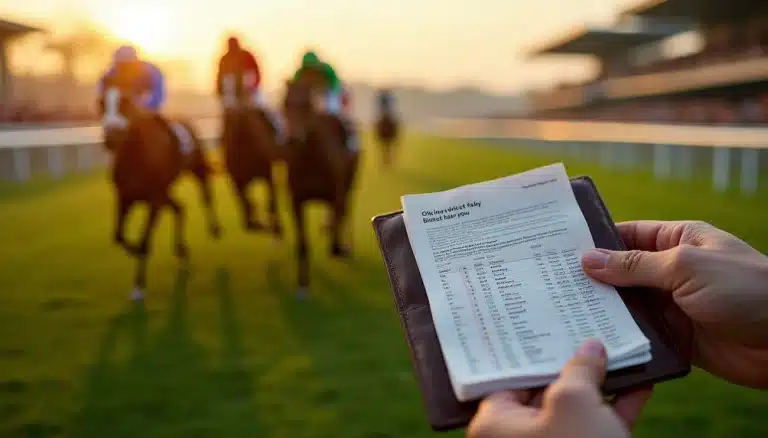Horse racing betting strategies can improve your chances of winning at the track. This applies whether you’re new to betting or you’re a seasoned punter. A £100 Pick 3 bet could put £8,000 in your pocket if your picks come through
Horse betting strategy isn’t one-size-fits-all. Smart bettors don’t just rely on luck – they understand different betting types and methods. Show bets make sense for beginners since your horse just needs to finish in the top three spots. Experienced bettors might prefer Trifecta bets. These bets are tougher to win but can pay out big.
The best way to bet on horse racing requires a balanced approach. To name just one example, the 80-20 strategy works well. You put 80% of your stake on a favourite and 20% on an outsider. This creates a smart mix of safety and potential profit. Understanding “value” is a vital part of winning consistently. Look for horses with odds better than their actual chance of winning.
Good bankroll management keeps your losses in check. Expert bettors suggest you bet only 1-5% of your total bankroll on each race. This piece will help you explore these strategies and make smarter betting choices at the track.
Understanding the Basics of Horse Racing Bets
Smart horse racing betting starts with learning the basics of different wagers, odds, and potential returns. These fundamentals are the foundations of making better betting decisions at the track.
Win, Place, and Show bets explained
Let’s start with three simple bet types that work well for beginners:
Win bet: Your horse must cross the finish line first. This bet gives you the highest return among straight bets because picking the winner is tough. A £2 win bet at 4-1 odds pays £10 total – £8 in profit plus your original £2 stake.
Place bet: Your pick needs to finish first or second. The payouts are lower than win bets, but your chances of winning go up. Races must have more than five horses to offer this bet.
Show bet: Your selection must finish in the top three spots. This bet is the safest option and gives you the smallest return of these three straight bets.
Many players like the Across the Board bet. This combines all three bets on one horse. A £2 base bet costs £6 total. A win gets you all three payouts, second place pays place and show, while third pays just the show portion.
What are exotic bets?
Exotic bets need you to pick multiple horses in one race or several races. These bets are sort of hard to get one’s arms around, but can pay much more than straight bets.
Single-race exotic bets include:
Exacta: Pick the first two finishers in exact order. A £1 exacta box with two horses costs £2 and covers both possible finish orders.
Trifecta: Name the top three finishers in exact order. A three-horse trifecta box at £0.50 per combination costs £3 and covers every possible order.
Superfecta: Choose the first four horses in exact order. A four-horse superfecta box at £0.10 per combination runs £2.40.
Multi-race exotic bets ask you to pick winners in back-to-back races through Daily Doubles, Pick 3s, Pick 4s, and Pick 6s. The payouts can be huge – a winning £100 Pick 3 might return thousands.
How odds and payouts work
Racing odds come in two main formats: fractional (5-1) or decimal (6.0).
Fractional odds show potential profit first, then your stake. To cite an instance, 7-2 odds mean a £2 bet wins you £7 profit plus your stake back, totalling £9.
Decimal odds display your total return, including stake. Odds of 6.0 mean your £1 bet returns £6 if you win.
Horse racing uses pari-mutuel wagering, which differs from fixed-odds sports betting. Each bet type has its own pool. The track takes its cut (15-20%), then shares the rest among winning tickets. This means odds change until race time based on betting patterns.
Exotic bet costs depend on combinations. A six-horse trifecta box has 120 different possibilities (6×5×4), costing £60 at £0.50 per combination.
These betting basics give you the tools to create strategies that balance risk and potential returns at the track.

Top 5 Horse Racing Betting Strategies Explained
“Dutching is a betting strategy in horse racing where a customer selects multiple horses in a race to increase your chances of winning.” — SportsMemo Editorial Team, Sports betting strategy analysts
Smart horse racing bettors don’t just make lucky guesses. They use tested strategies that give them an edge at the track. Here are five proven approaches that will boost your betting success.
Dutching: Spreading your risk
You can back multiple horses in the same race with Dutching, which gives you better chances of winning. This strategy splits your stake across several picks so you’ll get the same profit no matter which horse wins.
A £50 stake on a six-horse race might be split between two horses you think have the best shot at winning. With equal odds of 3/1, you’d put £25 on each horse. A win from either horse would give you a £100 return.
Dutching’s biggest plus is that it cuts risk by covering multiple outcomes. The downside is that it usually brings smaller profits than single-horse bets.
80-20 Strategy: Balancing favourites and outsiders
The 80-20 strategy comes in two useful versions. The first puts 80% of your stake on a horse to place and 20% on it to win. This works great with higher-priced horses that look good to place but might struggle to win.
The second version backs two horses in one race – 80% goes on the favourite and 20% on an outsider. Take a £79.42 total stake as an example: you might bet £63.53 on a favourite at +200 odds and £15.88 on an outsider at +800 odds.
This balanced approach will give a reasonable return, whichever horse wins. It’s especially valuable in competitive races without a clear favourite.
Lay Betting: Betting against the favourite
Lay betting turns traditional wagering upside down – you bet that a specific horse won’t win. Stats show pre-race favourites only win about one-third of all races, which makes this a powerful approach.
You’ll need betting exchanges like Betfair to use this strategy. Your potential profit equals your stake, but your liability (possible loss) is the stake multiplied by the odds, minus the stake.
Let’s say you lay £79.42 on a horse at +400 odds. If it loses, you win £79.42. But if it wins, you’d lose £317.66. This strategy shines when favourites seem overvalued due to course conditions, recent form, or other factors.
Pick 3 and Trifecta: High-risk, high-reward bets
These exotic bets can pay out big, though they’re tough to win.
Pick 3 needs you to choose winners in three straight races. You only collect if all your picks win. A successful £100 Pick 3 bet might return thousands. A £1.59 Pick 3 wager at the 2014 Belmont Stakes paid £229.12 – about 144-1 odds.
A Trifecta bet asks you to predict the exact first, second, and third-place finishers. A £1.59 Trifecta bet at the 2016 Belmont Stakes paid a whopping £2,184.73. You might want to try a “boxed” Trifecta, which lets your picks finish in any order, though it costs more.
Show Betting: Safer bets for steady returns
Show betting offers the lowest risk in horse racing and works great for beginners who want steady returns. Your horse just needs to finish in the top three positions to win.
The idea is to back favourites or near-favourites to place in the top three at modest odds. Single payouts won’t be huge, but your balance should grow steadily across multiple races.
Some bettors try this with outsiders, hoping they’ll grab third place for bigger returns. This variation comes with much more risk though.
How to Analyse Races Like a Pro
Professional horse bettors stand apart from amateurs through their analytical mindset. They get into multiple factors before placing bets, which gives them an advantage over casual bettors who bet on hunches or names.
Reading horse form and past performance
Race cards display form figures to the left of a horse’s name, with the most recent result on the far right. A sequence like “4893241” shows the horse won its last race and came fourth in the previous one. These symbols tell a vital story:
- C means a course winner
- D represents a distance winner
- CD shows wins over both course and distance
- BF indicates a beaten favourite
Looking beyond these symbols reveals the bigger picture. A sixth-place finish might not tell the whole story – the horse could have faced interference or received poor handling. Race replays help assess a horse’s actual performance, so watch them whenever you can.
Understanding track conditions and distance
Track conditions shape race outcomes. Turf course racing times range from fastest to slowest: firm < good < yielding < soft. Horses that shine on firm ground often struggle in soft or yielding conditions.
Each horse performs best within a specific distance range based on its speed and stamina. Before backing any horse, check its record over the race distance. Horses with two or more wins and a 25%+ win rate at that distance deserve extra attention.
Evaluating jockey and trainer stats
Jockey-trainer combinations affect race results in a big way. Look at these key factors:
- Win percentages (20 %+ shows excellence)
- In-the-money percentage (top three finishes)
- Track-specific performance records
- Recent form in their last 10-20 races
Some jockey-trainer pairs show exceptional chemistry and deliver better results than their stats might predict.

Building Your Horse Betting Strategy
“If the typical handicapper has one fatal flaw, it is that he has no consistent betting strategy and makes no effort to formulate one.” — Andrew Beyer, Renowned horse racing columnist and author of ‘The Winning Horseplayer’
Success at the track demands more than a single method. The most profitable horseplayers create their own strategies. They build unique systems that evolve with experience and results tracking.
Combining multiple strategies
Racing profits consistently flow from multiple betting approaches. Professional punters spot different opportunities throughout a racing card:
“I see too many people rely solely on backing horses and miss out on the profits they could make by laying weak favourites or the ‘safe’ profits made from learning to trade in the pre-race markets”.
The morning race card review should identify specific races for different strategies. Some races suit backing a selection, others work better for laying a vulnerable favourite. Trading opportunities might emerge in other races. This mix of approaches helps you leverage various edges instead of forcing one strategy across all races.
When to bet and when to skip
Discipline sets successful horse bettors apart from others. The golden rule states: “There’s always another race”. Several factors matter before placing any bet:
- Field size (races with more than 12 runners are harder to predict)
- Ground conditions (good or good-to-firm ground delivers more predictable results)
- Recent form (horses need a run within the last 28 days for a reliable assessment)
Smart bettors view each wager as an investment decision. They skip races when odds lack value, even with promising selections.
Using value betting to your advantage
Value betting creates the foundation for profitable horse racing wagers. A value bet happens when a horse’s winning chances exceed what the odds suggest.
Value identification requires:
- Your own ratings based on form, class, speed figures, and trainer/jockey statistics
- Converting ratings to probability percentages
- Comparing calculated probability with bookmaker odds
- Betting when your assessment shows better chances than the offered odds
The path to successful value betting isn’t about picking every winner. It focuses on finding situations where odds work in your favour over time.
Bankroll Management and Risk Control
No horse selection method will work without proper bankroll management and risk control. Professional punters know that success over time depends equally on money management and horse selection skills.
Setting a betting budget
You need to set up a separate betting fund—money you can lose without impacting your daily life. This bankroll should stay completely separate from your regular finances to protect essential money. Expert bettors suggest starting small, with just £79.42, split into units for easier tracking.
Think of your betting budget as money spent on entertainment rather than a guaranteed investment. This mindset helps maintain discipline and prevents emotional decisions that often lead to losses.
Staking plans that work
Your bankroll can grow and stay protected with these proven staking approaches:
- Percentage Staking: Bet 1-5% of your total bankroll per race, while newcomers should stick to 1%. Your stake size adjusts naturally as your bankroll changes.
- Fixed Return: Calculate stakes to win a set amount, whatever the odds, usually aiming for 5 units per bet.
- Level Stakes: Bet the same amount on each selection, typically 0.5-2% of your betting bank.
Your unit size needs regular recalculation as your bankroll fluctuates. When your £7,941.60 bank drops to £7,147.44, reduce your unit size from £79.42 to £71.47.
Avoiding common betting mistakes
Chasing losses acts like kryptonite for gamblers, raising stakes to recover previous losses. This dangerous habit leads to bigger losses and can quickly drain your entire bankroll.
Watch out for these mistakes:
- Betting on every race instead of waiting for quality opportunities
- Poor record-keeping of your bets
- Using borrowed money or funds needed for bills
- Keeping the same stake sizes during losing streaks
These money management tips, combined with smart selection strategies, will boost your chances of long-term success in horse racing betting by a lot.
Conclusion: Putting It All Together for Betting Success
Horse racing betting creates exciting opportunities if you learn beyond simple wagers. This piece has covered strategies that can improve your track success by a lot.
A solid foundation comes from learning the basics. Win, Place, and Show bets work great for beginners. Exotic wagers like Exactas and Trifectas open up profitable possibilities for seasoned bettors. On top of that, you’ll make better decisions once you learn how odds work in the pari-mutuel system.
Each of our five core strategies serves a unique purpose. Dutching spreads risk across multiple horses. The 80-20 approach creates balance between favourites and outsiders. Lay betting utilises the fact that favourites lose about two-thirds of races. Pick 3 and Trifecta bets can bring big payouts with higher risk. Show betting remains your safest path to steady, modest profits.
Professional analysis separates random guessing from smart betting. You’ll get better results by reading form figures, checking track conditions, and evaluating jockey-trainer combinations before placing bets.
Your strategy should grow as you do. Successful bettors mix different approaches instead of sticking to just one. They know when to step away from bad odds and focus on value opportunities where odds beat a horse’s real winning chance.
Smart bankroll management protects you when losses happen. You need a dedicated betting budget, effective staking plans, and the discipline to avoid chasing losses to succeed long-term.
Profitable horse racing betting takes patience, discipline, and constant learning. No strategy wins every time, but these principles boost your chances of success. Start small and track your results. Adjust your approach as you develop your own way to beat the track odds.
Horse Racing Betting Strategies – Your FAQs
Q1. What is considered the most profitable horse racing betting strategy? Value betting is often regarded as one of the most profitable strategies. This involves identifying horses that bookmakers have underestimated, betting on them when their actual probability of winning is higher than what the odds suggest.
Q2. How should I manage my betting bankroll for horse racing? Set aside a dedicated betting budget that you can afford to lose without affecting your daily life. Many experts recommend starting with a modest amount and dividing it into units. Stick to betting only 1-5% of your total bankroll per race, with beginners staying closer to 1%.
Q3. What types of bets are recommended for beginners in horse racing? For beginners, straight bets like Win, Place, and Show are recommended. These are simpler to understand and offer lower risk. Show betting, where your horse needs to finish in the top three, is particularly safe for those starting out and looking for steady returns.
Q4. How can I analyse horse races more effectively? To analyse races like a pro, focus on reading horse form and past performance, understanding track conditions and race distances, and evaluating jockey and trainer statistics. Pay attention to factors like recent form, course suitability, and successful jockey-trainer combinations.
Q5. What is the 80-20 strategy in horse racing betting? The 80-20 strategy involves splitting your stake, with 80% on a safer bet and 20% on a riskier one. This can be applied by either placing 80% of your stake on a horse to place and 20% to win, or by backing two horses in the same race – 80% on the favourite and 20% on an outsider.




